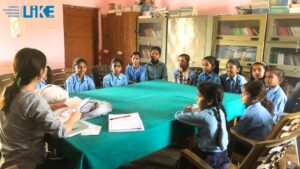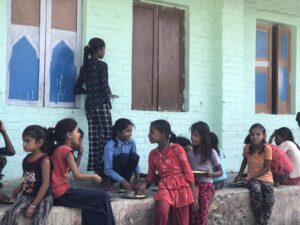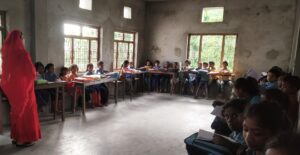Author: Regina Rajbanshi
Both gender equality and social inclusion are interrelated ideas that enable all the people, especially those who are excluded, marginalized, women, and less economically stable, to have better access to resources and services. And, to equalize and overcome various social and gender based differentials, GESI framework advocates for inclusive policies and concentrates on enhancing the influence of the people belonging to underprivileged community, women and excluded groups in different institutions and circumstances associated with social and political and economical outreach.
Moreover, the initiative “Effectiveness and Scalability of Programs for Children Who Are Out of School and at Risk of Dropping Out in Bangladesh, Bhutan and Nepal’’ recognizes that the prevalence of differentials and disparities in terms of gender equality and social inclusion among students as main concerns in the public schools. Therefore, to examine gender and other social differentials that undermine equality, equity and social inclusion in the context of public schools GESI diagnosis framework has been formulated. This conceptual framework has been derived from Amartya Sen’s capability approach and it comprises of four major concepts such as gender, equity, equality and social inclusion. Operations definitions, conceptual understandings and indicators associated with these variables developed within the theoretical frame of capability approach are based on the contributions of Unterhalter (2009), Melanie Walker (2007), and Mario Briggeri (2004), and these scholars and social scientists have worked for years in the field of children education.
Furthermore, the GESI framework has been designed by the combination of conceptual frameworks of 4 sub-research projects of “Effectiveness and Scalability of Programs for Children Who Are out of School and at Risk of Dropping Out in Bangladesh, Bhutan and Nepal’. These 4 sub-research projects have carried out their respective studies at the public schools of Yamuna Mai rural municipality, Rautahat district of Nepal. The titles of the sub-research projects are as follows-
· Gender (in) equality in Education: A Study of Rural Community Schools at Rautahat District.
· A Study on the Status of Equity in Basic Education at Yamuna Mai Rural Municipality.
· Equality in Public Education: A Study of Public schools at Yamuna Mai Rural Municipality
· Social Exclusion in Public Education: A study of Public Schools at Yamuna Mai Rural Municipality, Rautahat
The schematic diagram of the framework is as below:

Each four major concepts of this framework have been elaborated in details along with theoretical reference and relevant indicator together with suitable diagrams, as follows:

First of all, for the purpose of measuring the gender equality in public schools of Yamuna Mai rural municipality, Rautahat district different thematic orientations such as participation, bodily integrity, resources and respect were generated with reference to Walker’s list of capabilities. After that, indicators were set for each particular theme. For instance, in order to measure and evaluate equal participation of boys and girls in teaching and learning activities different indicators such as asking questions to teachers in the classroom, participation in question-answer-sessions, raising hands, participation in sports and training were constructed.
Similarly, indicators such as safety concerns of boys and girls at the school, violence and harassment, experience of bullying from friends and corporal punishment were developed to measure and evaluate bodily integrity. Likewise, in order to evaluate gender equality in terms of access to resources, constructs such as availability of separate toilets for girls and boys, provision of sanitary pads, facilities inside toilets were set as indicators. Finally, to measure respect; factors such as discrimination based on gender, greetings from teachers, treated with dignity were discerned as core indicators.

The next concept in this conceptual framework is equity in education as conceptualized in three dimensions by Elaine Unterhalter (2009); equity from above, equity from middle and equity from below. Equity from the above dimension observes the policies and programs of the government. There are various examples of equity from above in the context of Nepal such as each and every citizen has the right to access to basic education from the state for free, free higher education as per law to the persons with disabilities and to people belonging to economically disadvantaged families. Equity from the middle in education is associated with the movement of ideas, time, money, skill, organization or artifacts that facilitates ‘investments’ in the learning of children or adults. Similarly, equity from below observes participation of students in schools through activities such as negotiation, discussion and questioning.
Moreover, the sub-projects as indicated above in their field studies have measured and evaluated equity from above in public education through indicators such as compulsory and free education, mid-day meal program, scholarship program and mother tongue-based multilingual education. Likewise, equity from the middle was measured through “quality of resources provided by stakeholders. These sub-projects evaluated the distribution of resources in rural community schools with reference to different levels of caste, class, ethnicity, religion and gender. However these studies didn’t examine and evaluate whether or not textbooks, library, uniforms had been delivered, these studies only focused on evaluating the extent to which they were fairly delivered among rural students. Similarly, equity from below was measured with reference to “voice”. Here, voice indicates the participation of students in the school. It is measured through different indicators such as participation in question-answer sessions and raising hands among rural students from different caste, class, ethnicity, religion and gender.

The third concept- “equality” was measured with reference to Elaine Unterhalter’s lens of viewing three different dimensions of equality in education: distributive equality, equality of condition, and equality of capability. The distributive dimension examines the distribution of goods and services that ensure equality in education. For this purpose, in the study conducted by sub-projects, the equal distribution of mid-day meals, textbook, uniform, stationary and cycle were examined. Equal distribution of resources is the prime objective of this concept. The second approach- equality of condition draws attention to how equality in education is associated with the fair condition and enabling environment for each and every individual. In these sub projects, the condition of the community schools was examined through indicators such as, the availability of classroom space, desk/bench and first-aid including separate toilets for girls and boys.
Similarly, the third and final dimension has been derived from the works of Amartya Sen, equality of capabilities; this concept evaluates social policy, including education, without ignoring individual aspirations or dictating social benchmarks. The GESI framework further explores whether students are provided with sets of opportunities such as built-up areas, electricity, and drinking water that helps in the effective functioning of the students. Besides, proper availability of these sets of basic resources enables the student to focus on their capabilities to achieve their educational well-being.

The last concept of the GESI framework is related to social inclusion and this factor can be examined by creating themes such as resources, participation, curriculum and freedom from economic and non-economic exploitation. These themes were derived from Mario Briggeri (2004) list of capabilities that are relevant for evaluating inclusive participation of children at different educational settings with diverse socio-economic dimensions. For the purpose of understanding different levels of inclusion associated with available school resources, disabled-friendly infrastructure was selected as an indicator. Disabled-friendly infrastructure is an integral part of any inclusive environment. Hence, the lack of access to a disabled-friendly environment leads to capability deprivation of the children living with disability, which in turn further culminates into social exclusion.
Likewise, the extent and frequency of participation of students, in relation to their economic background, caste, religion and gender, regarding sports and training activities were also acknowledged as indicators to measure social inclusion. Similarly, to examine and evaluate the level of inclusion associated with curriculum and curricular activities, availability of Braille textbooks for the children with disabilities were considered as an indicator. In addition, indicators such as household chores and external responsibilities were developed to measure inclusion under the theme of freedom from economic and non-economic exploitation.



